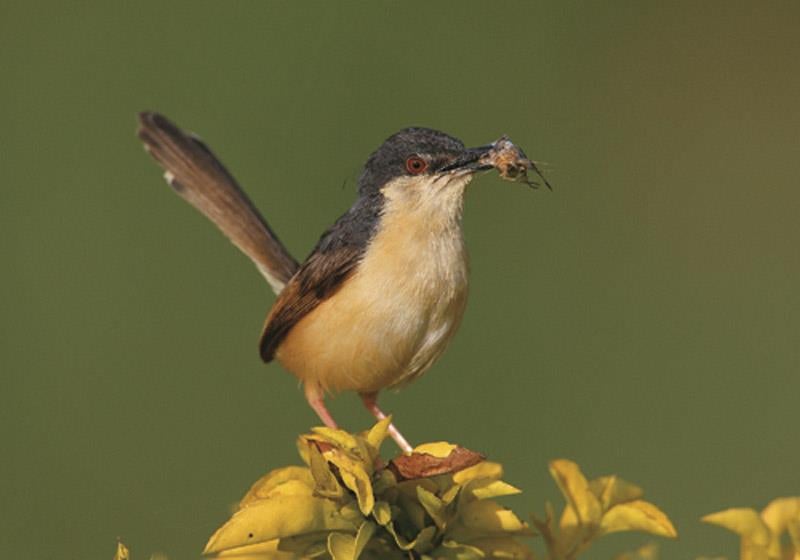When I train my glasses on the tree about 100m ahead, at first I can only see
Just as magical is the fact that I am in the heart of metropolitan Chennai. The reserve forest of Nanmangalam where I am standing is a stone’s throw from nasty, dusty Velacheri. In fact, my car is parked on the main road and we just walked into the woodland that lines the road here and stretches across to Tambaram. This dipping, rising stretch of wooded hills and valleys, filled with birds and other small wildlife, is one of the last bits of green still standing, and it’s gut-wrenching to wonder how long it will be before the insidiously expanding city eats this up too.
As we stand atop one of the hillocks, we spot Indian robins and bulbuls, palm swifts and koels and drongos in profusion, and a glimpse of the great owl as it takes off for another perch in the forest spread out ahead of us; while away to the right, the white urban sprawl with its boxes and chimneys crouches menacingly on the edge of the green.
From one such white concrete box I have emerged, much earlier than normal for me, four mornings this last month to discover the joys of birdwatching in Chennai. Well, to be honest, I am one of the lucky few who sees white-breasted kingfishers, purple sunbirds, even hoopoes in my garden, and I wake up this time of the year to the piercing call of the glossy black koel who nests in the mango tree in my backyard. But I am greedy for more, so I collar Capt. Subbu and we head first to the Guindy National Park, one of the few worldwide to be located in the middle of a city. What a find! In the first few minutes, we spot rufous treepies, magpie robins, red-vented bulbuls, kites, tailorbirds and parakeets; and the abandoned polo ground inside is awash with yellow- and red-wattled lapwings with their distinctive ‘Did you do it?’ cries. With shouts of surprise we greet the sight of dozens of endangered star turtles walking ponderously about the field, while a brown hare darts away, a mongoose looks up surprised, and deer, naturally, are all over.
Next visit is Nanmangalam, whose highlight for me is the fabulous owl, of course, but also a clear sight of the majestic coucal (or crow pheasant), the black-shouldered kite, and the shikra, a type of hawk. We also spot the ashy prinia, spotted dove and common iora, thanks to Capt Subbu and his extraordinary eyesight.
The Pallikaranai Marsh is liable to make you a bit miserable. What used to be 100 sq km of birds’ paradise has been systematically reduced by development and dumping to a measly 10 sq km today, with mountains of rubbish still looming over the rest. What’s left of the marshes you see from the mephitic roadside, which means it’s not exactly a delightful walk but you get up close to such a wealth of birdlife that anything seems worth it.
Stylish black-winged stilts, plump purple moorhens, darters, herons and egrets abound. You have to be careful to avoid occasional sightings of the Naked Rumped Human but aside from that it’s pure pleasure. We head for another stretch and there’s a pristine white pelican meditating on the gleaming water, surrounded by a host of dabchicks swimming and fishing busily. There’s a solitary flamingo, waiting regally for a careless fish, while a few dramatic black-headed ibis float by. Then we get lucky — a pair of the rare glossy ibis lands right in front while the pheasant-tailed jacana, in exotic breeding plumage, saunters in the background.
The Adyar estuary, seen from the broken bridge at the far end of Elliot’s Beach, used to once teem with water birds but habitation has put paid to that, and of course, it’s the wrong season. It still makes a charming vantage point though, with land birds galore. I see my first green bee-eaters and Loten’s sunbirds in dozens but I’ll treasure most the spectacular sight of a veritable flock of coppersmith barbets, resplendent in red, green and yellow, landing on a bush just a stretch away.
I have always travelled far — Bharatpur, Ranganathittu, Vedanthangal — for the pleasure of birding. And now I discover this booty in my backyard so to speak. I’ve decided I should reward myself with a fine pair of binocs.
Best time: 5am-8am, September-March. Carry: Water, binocs, favourite field guide, snacks. Avoid: Big groups, small children, cellphones, strong perfumes, tetchy co-walkers, going alone.
Contact: Madras Naturalists’ Society (044-24995833, www.blackbuck.org.in). Birder and MNS member Capt KR Subramoniam undertakes guided tours (9841575740, [email protected]).


